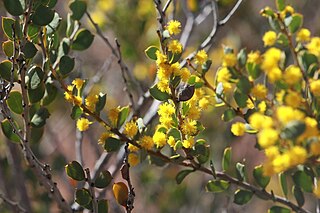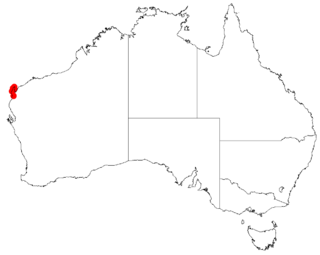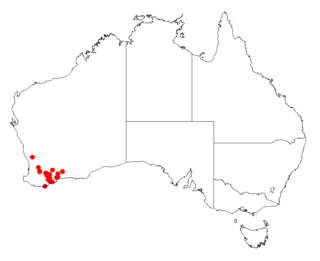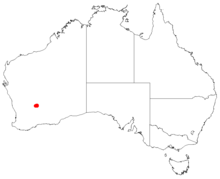
Acacia acanthoclada, commonly known as harrow wattle, is a species of flowering plant in the family Fabaceae and is endemic to southern continental Australia. It is a low, highly branched, spreading and spiny shrub with wedge-shaped to triangular or egg-shaped phyllodes with the narrower end towards the base, and spherical heads of up to 30 flowers, and linear, spirally-coiled pods.

Acacia aemula is a species of flowering plant in the family Fabaceae and is endemic to the south coast of Western Australia. It is an openly-branched, often prostrate, rush-like subshrub with cylindrical to more or less flat and linear phyllodes similar to its branchlets, spherical heads of cream-coloured or golden-yellow flowers and reddish-brown, thin, paper-like or crusty pods.

Acacia bifaria is a shrub belonging to the genus Acacia. It is native to an area along the south coast of Western Australia.

Acacia arcuatilis is a species of flowering plant in the family Fabaceae and is endemic to the south-west of Western Australia. It is a rounded, spreading shrub with curved phyllodes, racemes of usually two spherical heads of yellow flowers in axils, and linear pods up to 60 mm (2.4 in) long.

Acacia acanthaster is a species of flowering plant in the family Fabaceae and is endemic to the south-west of Western Australia. It is a rigid, densely-branched, domed shrub with flat, linear phyllodes, spherical heads of golden-yellow flowers, and curved pods that resemble a string of beads.

Acacia acoma is a species of flowering plant in the family Fabaceae and is endemic to inland ares of south-western Western Australia. It is an erect, spindly, open or spreading shrub with variably-shaped, often narrowly oblong phyllodes, flowers arranged in spherical heads, usually arranged in pairs in leaf axils, and strongly curved or spirally coiled pods up to 15 mm (0.59 in) long when expanded.

Acacia aculeiformis is a species of flowering plant in the family Fabaceae and is endemic to the south-west of Western Australia. It is prostrate, scrambling, mat-forming shrub with asymmetrical elliptic to narrowly elliptic phyllodes, and spherical heads of light to medium golden-yellow or yellowish-red flowers.

Acacia alexandri is a species of flowering plant in the family Fabaceae and is endemic to the Cape Range in the north-west of Western Australia. It is a glabrous shrub with slender branchlets, linear phyllodes, and cream-coloured flowers arranged in 1 or 2 spherical heads in the axils of phyllodes, and narrowly oblong, papery pods up to 70 mm (2.8 in) long.

Acacia amblygona, commonly known as fan wattle or fan leaf wattle, is a species of flowering plant in the family Fabaceae and is endemic to continental Australia. It is a sprawling, sometimes prostrate shrub with sharply-pointed, lance-shaped, tapering phyllodes, golden-yellow flowers arranged in a spherical head of 10 to 18 in the axils of phyllodes, and curved, coiled or twisted pods up to 70 mm (2.8 in) long.

Acacia andrewsii is a species of flowering plant in the family Fabaceae and is endemic to the south-west of Western Australia. It is an intricately-branched shrub with narrowly oblong to lance-shaped, sometimes linear phyllodes, spherical heads of 20 to 30 golden-yellow flowers, and leathery pods up to 65 mm (2.6 in) long.

Acacia aphanoclada, also known as Nullagine ghost wattle, is a species of flowering plant in the family Fabaceae and is endemic to a small area in the Pilbara region of Western Australia. It is a glabrous wispy shrub with narrowly linear phyllodes, racemes of spherical heads of golden flowers, and narrowly oblong, papery pods up to 60–70 mm (2.4–2.8 in) long.

Acacia argutifolia, commonly known as East Barrens wattle, is a species of flowering plant in the family Fabaceae and is endemic to the south of Western Australia. It is a low, spreading, intricate shrub with linear phyllodes, spherical heads of pale yellow flowers, and narrowly oblong, somewhat papery pods up to 40 mm (1.6 in) long.

Acacia aristulata, also known as Watheroo wattle, is a species of flowering plant in the family Fabaceae and is endemic to a restricted area in the south-west of Western Australia. It is a shrub with narrowly oblong to wedge-shaped phyllodes, spherical heads of creamy-white flowers, and coiled to twisted pods up to 60 mm (2.4 in) long.

Acacia concolorans is a shrub belonging to the genus Acacia and the subgenus Phyllodineae that is endemic to Western Australia.

Acacia profusa is a shrub of the genus Acacia and the subgenus Phyllodineae that is endemic to south western Australia.

Acacia ryaniana is a shrub of the genus Acacia and the subgenus Phyllodineae that is endemic to an area along the west coast of Australia.
Acacia amyctica is a species of flowering plant in the family Fabaceae and is endemic to the south-west of Western Australia. It is an erect, bushy shrub with ascending to erect, narrowly lance-shaped, sharply-pointed phyllodes with the narrower end towards the base, spherical heads of 18 to 25 golden flowers, and linear to strongly curved pods.

Acacia ancistrophylla is a species of flowering plant in the family Fabaceae and is endemic to southern Australia. It is a dense, rounded shrub, with lance-shaped phyllodes with the narrower end towards the base, spherical heads of yellow flowers, and linear pods up to 40 mm (1.6 in) long.

Acacia anserina, also known as hairy sandstone wattle, is a species of flowering plant in the family Fabaceae and is endemic to a small area in the Kimberley region of Western Australia. It is an erect, openly-branched shrub with its branchlets densely covered with soft hairs, widely elliptic to widely egg-shaped phyllodes with the narrower end towards the base, spherical heads of 17 to 25 light golden flowers, and narrowly oblong pods up to 4–5 mm (0.16–0.20 in) wide.

Acacia amputata is a species of flowering plant in the family Fabaceae and is endemic to the south-west of Western Australia. It is a much-branched, spreading shrub with spiny branchlets, small bipinnate leaves, light golden flowers arranged in spherical heads of 10 to 20, and wavy or coiled pods up to 15 mm (0.59 in) long.





















